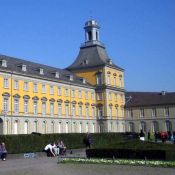Bonn Picks up Where Oslo, Copenhagen, and Nairobi Left Off
In the past two weeks, we’ve seen representatives from 52 nations pledge to forge common framework for rewarding people who capture carbon in trees and representatives from nearly 200 nations agree to come up with innovative financing schemes for preserving biodiversity. Now, negotiators from 182 nations are meeting in Bonn, Germany, for two weeks of climate talks.

In the past two weeks, we’ve seen representatives from 52 nations pledge to forge common framework for rewarding people who capture carbon in trees and representatives from nearly 200 nations agree to come up with innovative financing schemes for preserving biodiversity. Now, negotiators from 182 nations are meeting in Bonn, Germany, for two weeks of climate talks.
31 May 2010 | BONN | Only six weeks of official negotiating time remain between now and year-end climate talks in Cancíºn, Mexico, and the two-week session launched today in Bonn represents roughly one-third of that time.
Few here expect a year-end deal under the auspices of the United Nations Framework Convention on Climate Change (UNFCCC), but the talks are expected to yield agreement on certain provisions that will, at the very least, make it easier to forge multilateral and bilateral agreements once the Kyoto Protocol expires at the end of 2012.
Provisions for reducing greenhouse gas emissions from deforestation and forest degradation (REDD) are being handled in a negotiating tract called the Ad Hoc Working Group on Long-term Cooperative Action under the Convention (AWG-LCA), which on Tuesday begins working on a completely new negotiating text drafted in May by group chair Margaret Mukahanana-Sangarwe.
The AWG-LCA was formed as part of the Bali Action Plan, which split negotiations into two tracts: the AWG-LCA, which aims to come up with a completely new protocol for when the Kyoto Protocol expires, and the Ad Hoc Working Group on Further Commitments for Annex I Parties under the Kyoto Protocol (AWG-KP), which is focused on negotiating those parts of the Kyoto Protocol that will be kept.
The new AWG-LCA text incorporates parts of the Copenhagen Accord, which recognizes both the importance of REDD and of setting emission-reduction targets based on the goal of keeping average global temperature increases below 2%.
In addition to the AWG-LCA and the AWG-KP, two UNFCCC standing committees are also meeting in Bonn. The Subsidiary Body for Scientific and Technological Advice (SBSTA) focuses on scientific issues, and the Subsidiary Body for Implementation (SBI) focuses on the nuts and bolts of implementing agreements.
The Other Inputs
Last week in Oslo, representatives from 52 countries agreed to be ‘REDD+ Partners’ working to promote proper implementation of REDD in and outside of UNFCCC talks. At the same time, participants in Nairobi biodiversity talks set their sites on making sure that biodiversity values are incorporated into a REDD scheme.
We will be covering these inputs, as well as all developments impacting land-use, over the next two weeks.
Steve Zwick is Managing Editor of the Ecosystem Marketplace. He can be reached at [email protected].
Please see our Reprint Guidelines for details on republishing our articles.
Additional resources
Please see our Reprint Guidelines for details on republishing our articles.

